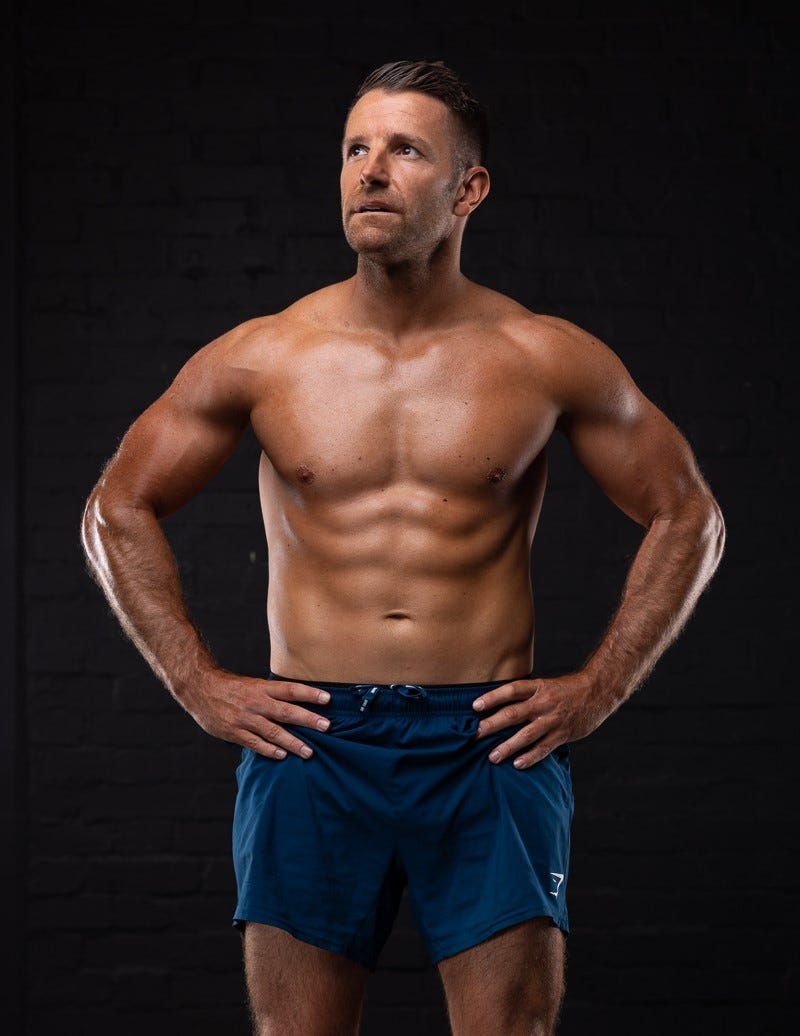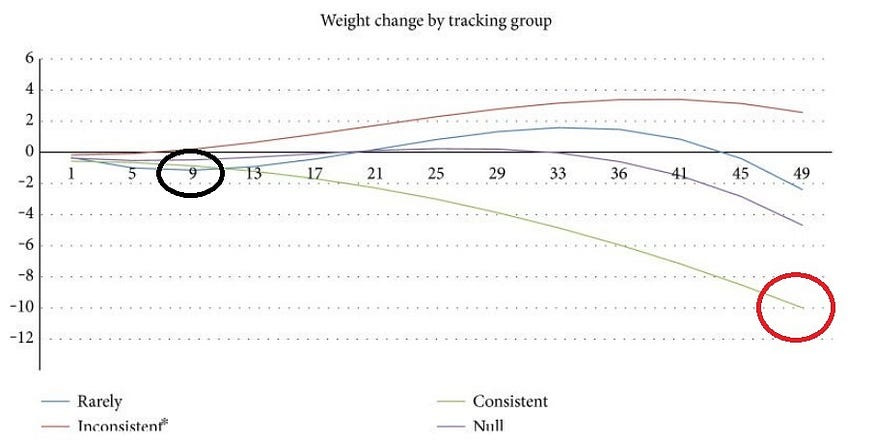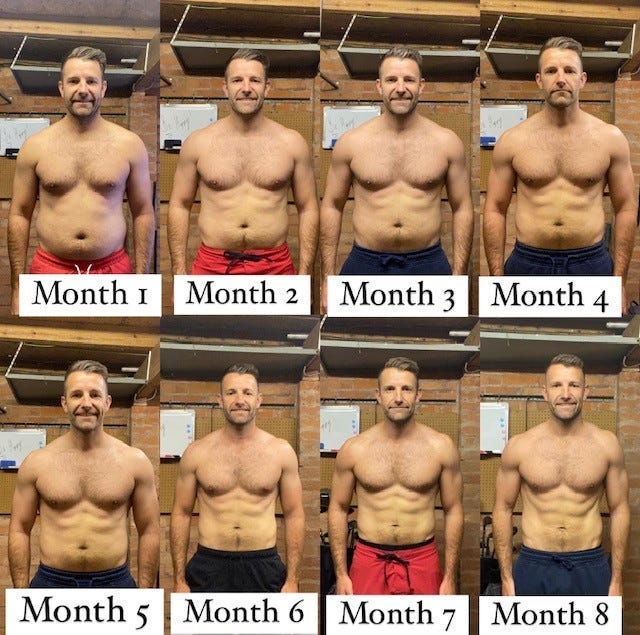The Most Effective Method I Used To Fix My Potbelly at 37, I Hear Almost No One Talking About.
It has little to do with your age or “metabolism.”

It changed my life.
I lost 30+ pounds in 6 months and have maintained abs for eight months, proof here.
I’m not saying this to brag or “try and get laid”, as one commenter put it, but rather to offer credibility to the conversation.
I’m the guy who tried everything under the sun. Paleo, Keto, 5/2, Vegan, skipping breakfast, you name it.
They worked poorly for me because it required cutting out certain food groups, which was too restrictive when everyday life events occurred, like being invited to dinner or weekends away; I’d crash and burn.
It didn’t suit the real world.
Everything changed once I used this standard method for losing weight but added some key ingredients to ensure it worked.
When I sprinkled them into my framework, it worked like a wizard’s potion.
Let’s dive in.
Cut your intake and crank up the motion.
The subtitle above should be as obvious as a slap in the face.
It’s frustrating when credible “experts” try to sound edgy with “new” or “groundbreaking information” about weight loss.
It’s simple: Eat less, move more.
But take Doctor Tim Spector, featured on The Diary of A CEO, who says exercise doesn’t help weight loss and that we must “Stop obsessing about calories; there’s never been any long-term study showing that calorie counting is an effective way to lose weight and maintain weight loss after the first few weeks.”
When I watched the episode above, I face-planted the palm of my hand. It felt like it was in aid of trying to get views and hook you in, but it’s a message confusing people.
There is a cascade of studies proving energy put into your body in the form of food, minus output in the form of exercise, will either make you gain or lose weight. You could explain the concept to a five-year-old.
One research paper submitted by the Cardiometabolic Research Institute said:
“The prevailing concept of caloric restriction, often called the “calories in, calories out”, remains a fundamental principle in obesity management. Energy balance, which involves the relationship between calorie intake and expenditure, is crucial in obesity”.
Here’s my living proof and precisely how I did it.
I started by speaking to a qualified expert who pointed me toward using a BMR calculator as my first port of call.
We got to a figure of 2,500 calories.
The American Council on Exercise (ACE) say using a BMR calculator is the most accurate method for estimating the number of calories your body burns over 24 hours.
It’s the dial on the fuel gauge.
You must know this because it’s like working out how much fuel you need in the tank to keep running.
By understanding how many baseline calories you need, you can work out how much energy you need to lose, gain, or stay a similar weight.
Remember, it’s a moving target considering age, weight and height. So, I followed the standard 20% and restricted my calories to 2000 daily, shaving off 500 daily.
According to most experts, shaving off 500 calories (for men) is standard regarding effective weight loss.
It equates to a deficit of 3,500 weekly, typically resulting in between ½ a Lbs and 1lb weight loss per week with an exercise plan.
I was losing 1 pound weekly.
At 37, my weekly activity schedule helped me lose 33 pounds in 8 months as of publishing.
Here’s what it included.
10,000 daily steps
Three, 5KM runs
Three 45 minutes weight sessions
Author’s Remark — I hired my friend Chris James (online fitness pro) to help me on my journey— Chris is offering a free discovery call for anyone who wants to discuss their fitness journey.
There’s no obligation to join his programme, but if you do, I’ll receive a small referral to help fuel my coffee addiction — what’ll make me happier is boasting about your results!
Having a quality diet is easy when you know what to do.
The counterargument to Calorie counting is always the extreme, “Well, you can’t just have 2000 calories of sugar”. That would be at the top of the totem pole for apparent statements.
Once I realised that yes, it is about “calories in vs. calories out”, but if you’re even just a little savvy about what fuel you put into the tank, you’ll burn excess weight like a furnace.
Repeat after me, “Macronutrients”.
You need to have macronutrients or “macros,” which are the foods that provide us energy, commonly measured in calories.
Once I applied this, I had consistently more energy, didn’t always feel starving, and recovered quicker from exercise.
The three macronutrients experts say you want in every meal are Protein, which is four calories per gram; Carbohydrates, which is also four calories per gram; and Fat, which is dense at nine calories per gram.
A food scale is a weight loss weapon you should invest in because eyeballing portion sizes is a lottery.
I try for an even split of all three macros in each meal with slightly lower fat, i.e. 35–40% Carbs, 35% Protein and 25% Fat.
Generally, dietitians and medical experts advise a macronutrient breakdown of 20%-30% fat, 30% protein and 40%-50% carbohydrates because it balances all three energy sources.
Here’s my typical day eating
I eat around 500 calories per meal mainly because 550 or 430 don’t seem round enough.
So I have 500 calories for three main meals, which equals 1,500, leaving me 500 in reserve for some snacks, which I use for a cappuccino almost every day from a family-run coffee shop down the road and a Grenade bar and a hot chocolate in the evening.
Here’s my daily grub – warning: It’s nothing to write home about, but I like eating it. It’s also not set in stone — some caveats are below.
Breakfast: Two tablespoons of Peanut Butter (188 cal) on two pieces of toast (160 cal) with a protein shake (130 cal)
Snack: Half a Grenade bar (110 cal)
Lunch: 150 grams chicken cooked (250 calories) + one and a half fajita wraps (150 calories) sprinkled with 30 grams light mature cheddar (100 calories)
Snack: The other half is that Grenade bar (110 cal) and a cappuccino(130 cal)
Dinner: Half a cup of Basmati Rise (83 cal), Half a cup of Lentils (115 cal), One yellowfin tuna (150 cal) and one tablespoon of extra virgin olive oil (120 cal)
Half a cup of cooked Basmati rice is happiness on a plate — it’s a high-volume food, filling but very low in calories.
I’ll eat the rice most nights and swap the meat up — some nights, it’s chicken and others, I’ll do steak.
Occasionally, I’ll incorporate lentils or broccoli into my evening meals — on Sundays, it’s all about the veggies for my roast dinners.
For variety and to save some mullah, I’ll have a diced apple with peanut butter and a protein shake instead of the Grenade bar. I also enjoy a good mango as a sweet treat (sporadically).
It’s a system I could now do blindfolded.
The winning formula is always a blend of both
I was part of the crowd that thought counting calories was nonsense.
That’s until a horse kicked me in the head (Joking). No, that’s until I did some solid research. I realised I was making some common mistakes you might be making, too.
I tried to create a calorie deficit solely through diet and no exercise, or on the other end of the spectrum. I’d do it solely through exercise and no diet.
I tried to compensate for a poor diet with intense exercise and burning calories, but it was like emptying a flooded boat with a teaspoon. I wasn’t paying enough attention to what I ate, leading to overeating and no weight loss.
You can bank on the truth of the saying that a bad diet will always have the upper hand.
IT WORKED LIKE A WINNING LOTTO TICKET when I simultaneously exercised and tracked my calories together.
You’re leaving too much room for mishaps.
My most critical error was not tracking correctly and leaving room for ambiguity.
Before using tracking Apps like MyFitnessPal, I underestimated the calories I put into my body. Sometimes, I was off by thousands.
Research shows that one of the leading causes of obesity is the idea that you think you’re eating right, but your assessment of what goes into your mouth is as accurate as a fortune cookie.
Across 11,288 adults aged above 20, a National Health and Nutrition Examination Survey found 63% of obese adults thought their diet quality was excellent, while 70% had diet quality grades of F.
The study concluded that adults could not accurately assess diet quality because only 15% returned accurate diet quality assessments with 96% accuracy.
So overall, 75% of adults overrated their diet quality.
In another study, they concluded that “underreporting of energy intake from foods is a frequent finding in patients with disturbances in body weight regulation who are referred for obesity evaluation”.
Do these two things to bring it all together.
Before my body transformation, if anyone asked me how my fitness was going, I’d say, “I eat pretty well, cook at home, have Protein after workouts, and I’ve been trying to drink more water and stay off the booze”. Blah, blah, blah.
It was a bog standard run-of-the-mill response.
You might read that thinking it’s perfectly normal, but I was consuming 3000 calories per day when I tracked my first week on MyfitnessPal.
I was so far from pining the donkey’s tail because I had no prior tracking method apart from some vague narrative that I was eating right.
Once I changed these two things, it kicked the guesswork to the curb and pinned my consistency to the ground.
I used technology effectively: Your Apple iPhone or Android has a health app that tracks your steps if you keep your phone on you. If you download MyFitnessPal, you can track every meal, every litre of water, every calorie, and macro by scanning the barcode.
I got someone to check in on me: Find someone on the same journey as you, a friend, a buddy, or better still, an online coach who’s there to hold you accountable.
As the age-old adage suggests, “If it can’t be measured, it can’t be enhanced.”
When you face a roadblock, relying on guesswork just won’t cut it, and it keeps your path to improvement as elusive as trying to catch your own shadow.
One study measured the weight loss over an entire year of three groups of people: “rare trackers”, “inconsistent trackers”, and “consistent trackers.”
They found people who consistently tracked their habits showed sustained weight loss and still managed to lose weight during times we’d usually indulge, like the holiday season.
Week 9, circled in black, is Thanksgiving; all the other groups showed weight increases, while “consistent trackers” continued their downward trend.

Final Thoughts
Tracking your actions is like a compass that keeps you on course, but being kind to yourself gets you back in the saddle.
You’ll have days where you eat poorly and forget to track your calories.
My mindset defaulted into thinking I needed a whole new strategy, which was wrong. I just needed a fresh Monday to start again.
It’s a simple formula, but it takes some discipline at the start.
Eat less, move more.
Get your diet quality right.
Remember your “macros”, Carbs, Fats and Proteins in each meal.
Stop trying to create a calorie deficit solely through diet and no exercise or solely through exercise; the winning formula is always a blend of both.
If you aren’t losing weight in a calorie deficit, you aren’t tracking correctly, as studies suggest.
Use technology and another person for accountability to make yourself consistent.
Consistency is the undisputed champion of progress.
I eat what I like but consume fewer calories than my body requires because I put a framework of accountability around me, like an online coach and technology, to keep me on track.
I lost 33 lbs doing this, and it hasn’t felt for one day that I’m starving myself.
It also opens me up to a broader array of things I can eat and drink, which aligns more with my social life and has staying power.
It worked for me, so why not you?




